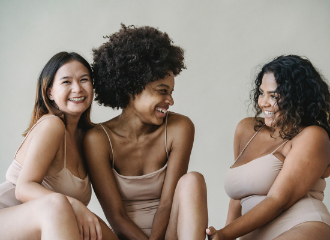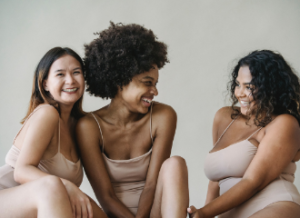Written by: Ashley Vicari, NCC, LCP (she/her)
Professional Relations Regional Manager, The Renfrew Center
Every body image movement brings a unique perspective to our culture. In this post, we define some of the biggest trends in the last few years and offer tips for how to think about them.
I invite you to pause for a moment and take a breath before you read the rest of this article.
I am going to give you an overview of some movements in our culture surrounding body image. But before I do, we both know that body talk is HARD. It’s messy. It can be very confusing.
So, pause. Breathe in. Hold. Breathe out. Repeat two-three times if needed.
Why Body Talk is So Hard
It’s no surprise to you that body talk is hard. We’ve been living with and in our bodies for our entire lives. People, culture, relatives, movies, magazines, social media, the doctor, the check-out lady at the grocery store, the high school coach, reality tv, the dance teacher, the baby-sitter, the friend’s mom, the clothing companies, I could go on and on and on and on… They’ve all said something to us about our bodies. It’s exhausting. It’s infuriating. And we live with it every day.
Body Image & Eating Disorders
Most eating disorder diagnosis, aside from ARFID, share a common criterion surrounding body image: an over-evaluation of shape and weight, meaning that someone with an eating disorder tends to put a lot of their eggs into the body image basket, so much so that it impairs their everyday lives.
Exploring Body Image, or “one’s thoughts, perceptions, and attitudes about their physical appearance,” (NEDA) is very much an integral part of working with someone who has an eating disorder. If we were to view it as a spectrum from total negative body image to body euphoria, most people may fall somewhere in the middle. Someone with an eating disorder, however, may exist closer to the negative body image side.
What Are Body-Positive Movements?
Over the years, there have been multiple movements that have emerged to assist individuals in engaging in healthy and healing talk surrounding their bodies. Many of these are trending on social media and most of them have been organically developed over the years as we collectively have sought to give individuals better language to both understand themselves and be understood. We are also aware that body image does not have a singular or linear path towards healing due to the nature of how someone may come to understand where they fall on the body image spectrum. Positive and negative life experiences, trauma, successes, culture, the families we are raised in, and mental health are all factors that contribute towards one’s body image.
5 Body-Positive Trends
Body Positivity: It’s important to understand and respect the roots and purpose of the body positive movement. Fat social justice activists in the 1960s termed the coin “body positive” and spearheaded the effort to center and liberate marginalized bodies from oppressions such as the thin ideal, weight stigma, racism, ableism, and fat phobia. The movement was designed to shift the focus from the thin-ideal and society’s image of “health” to the acceptance and celebration of all sizes, colors, abilities, genders, and weights. Over time, mainstream influencers, media outlets, and companies have co-opted the term “body positive”, distorting the definition and centering images of those who benefit from various physical privileges. Body positivity seeks to challenge dominant societal appearance (Cohen, R., et al., 2019).
Body Acceptance: Acceptance is a key principle in body positivity, however, while body positivity encourages one to love and affirm their bodies; body acceptance is the idea that one may not love their physical body, but they can accept their body as the vessel that moves them through life. Body acceptance allows someone to care and respect for their bodies even if they do not like or love their bodies.
Body Neutrality: Body Neutrality emerged after the body positivity/acceptance movements, it focuses on the helpful function that each body part can provide, while neither expressing love nor hate for this body part. Body neutrality encourages one to let go of judgements surrounding their body. This ideology can feel more congruent with someone who may have a harder time with the principles of acceptance and appreciation, as it is extremely difficult for everyone to feel grateful and safe in their bodies, especially for those living with chronic pain, coping with a physical illness, or simply existing in a culture rife with ageism, racism, fat phobia, and ableism. Body neutrality can create the space to cultivate an authentic identity that places less value, thought, and energy on the physical self and more value on deeply meaningful qualities and traits.
Body Respect: Body Respect shifts the idea of focusing on the physical body to more attention on what we can do with our bodies. It is about respecting the vessel enough to allow it to carry one to the place they want to go. For example, though one may not like an aspect of their body, they can respect their body while engaging in activities that make them feel more like themselves. This may be a helpful tool for someone who is experiencing gender dysphoria. Body acceptance can feel invalidating to someone whose gender identity does not match with the sex assigned at birth, so shifting to Body Respect may be more helpful.
Body Euphoria: The experience of feeling joy when one’s thoughts, feelings, and behaviors towards their bodies align and are congruent with their total being including their gender identity.
What Can YOU Do With This Information?
It is important to acknowledge here that these concepts are fluid in nature. It is quite normal to experience some level of body acceptance one day and a sinking amount of body dissatisfaction on another day. As you work to heal your experience with your body, please note that each day may look different, and that is ok. Also, just because one person may experience body euphoria does not mean you have to. These concepts exist to help you find what fits for you and your body, and quite frankly if you have hated your body for a very long time, it may be very challenging for you to buy into the concept of body positivity. Again, that is okay! You get to have your journey, and I promise you, it is not wrong.
10 Questions to Consider When Thinking About Body Image
- What are my body rules?
- Where did these rules come from?
- What function do these rules serve for me? Are they keeping me safe? Hidden?
- Can I practice non-judgement when looking at or thinking about my body?
- Am I able to see the purpose my arms, legs, stomach, etc. serves?
- Even if I do not like my body, what would respecting my body look like?
- Do I plan on living with my body rules all my life?
- How would my life be different if I respected by body?
- What matters most to me outside of my size, weight, and/or appearance?
- What role does the media or social media play in the way I view my body? What steps can I take to reduce or eliminate the harm of these images or messages?
Conclusion
Body image work is important work. The connection between our body image and mental health can be very strong and there is no one right path for a single individual to take. On your journey, as you are ready, I encourage you to consider the above questions. I encourage you to practice curiosity and free yourself of judgment. I encourage you to radically live your truth. I wish you safety. I wish you congruency. I wish you joy.
Sources:
- Cohen, R., et al. (2019). #bodypositivity: A content analysis of body positive accounts on Instagram [Abstract]. https://pubmed.ncbi.nlm.nih.gov/30831334/
- https://www.medicalnewstoday.com/articles/body-positivity
- National Eating Disorder Association (NEDA)
- https://www.verywellmind.com/body-positivity-vs-body-neutrality-5184565
- Body Neutrality: How Virtual Fitness Can Do Better (healthline.com)




